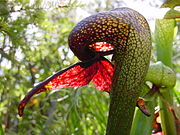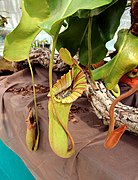Pitcher plant


Pitcher plants are several different carnivorous plants that have modified leaves known as pitfall traps—a prey-trapping mechanism featuring a deep cavity filled with digestive liquid. The traps of what are considered to be "true" pitcher plants are formed by specialized leaves. The plants attract and drown their prey with nectar.[1]
Types
The term "pitcher plant" generally refers to members of the
Nepenthaceae
The Nepenthaceae contains a single
Sarraceniaceae
The New World pitcher plants (Sarraceniaceae), which comprise three genera, are ground-dwelling herbs whose pitchers arise from a horizontal
The purple pitcher plant,
Cephalotaceae
The
Bromeliaceae
A few species of bromeliads (Bromeliaceae), such as Brocchinia reducta and Catopsis berteroniana, are known or suspected to be carnivorous.[3]
-
Nepenthes muluensis pitchers hang from tendrils. (This specimen is cultivated.)
-
Most North American pitcher plants belong to the genus Sarracenia.
-
Cobra lilies (Darlingtonia californica) use window-like areolae to lure insects into their hollow leaves.
-
The Australian pitcher plant is the only member of the Australian genus Cephalotus.
-
Pitcher of Nepenthes villosa
Feeding behavior
Attraction
Foraging, flying, or crawling insects such as flies are attracted to a cavity formed by the cupped leaf, often by visual lures such as anthocyanin pigments, and nectar. Many pitcher plants exhibit patterns of ultraviolet coloration which may play a role in attracting insects.[2] Some species, such as Cephalotus follicularis, likely use camouflage to trap insects, as their coloration matches that of the surrounding environment and the plants are often embedded in the substrate such that the traps are flush with the ground.[2]
Olfactory cues can also play a role in attraction. For example, Nepenthes rafflesiana uses flower-scent mimicry to attract insects to its pitchers.[4]
Capture
The rim of the pitcher (peristome) is slippery when moistened by condensation or nectar, causing insects to fall into the trap. The walls of the pitfall may be covered with waxy scales, protruding
Digestion
Whatever the mechanism of digestion, the prey items are converted into a solution of amino acids, peptides, phosphates, ammonium and urea, from which the plant obtains its mineral nutrition (particularly nitrogen and phosphorus). Like all carnivorous plants, pitcher plants all grow in locations where the soil is too poor in minerals and/or too acidic for most plants to survive. Pitcher plants supplement available nutrients and minerals (which plants normally obtain through their roots) with the constituents of their insect prey.[citation needed]
Feces-trapping symbiosis
Mature plants of
Nepenthes rafflesiana var. elongata has a similar relationship with Hardwicke's woolly bats (Kerivoula hardwickii).[8] The bats roost inside the pitchers and the plants derive much of their foliar nitrogen from the feces of the bats. Compared to other varieties of Nepenthes rafflesiana that do not exhibit this form of mutualism, N. rafflesiana var. elongata has elongated pitchers that can accommodate both single bats and mother-juvenile pairs. As well as its elongated shape, N. rafflesiana var. elongata has reduced volumes of pitcher fluid compared to other species, leaving more space to accommodate the bats.
Evolution of the form
It is widely assumed pitfall traps evolved by epiascidiation (infolding of the leaf with the adaxial or upper surface becoming the inside of the pitcher),
See also
- Darlingtonia State Natural Site – A nature preserve for pitcher plants in Oregon, United States.
References
- ^ PMID 21937485.
- ^ OCLC 71189676.
- S2CID 84947503.
- S2CID 82299236.
- PMID 25672361.
- doi:10.1071/IT96018.
- ^ Pitcher Plant Doubles as Toilet
- PMID 21270023.
- ^ PMID 1523408.
- PMID 10523280.
- ^ Pritchard; et al. (2002). "Evolutionary adaptations in pitcher plants". International Journal of Evolutionary Biology. 12 (3): 62–81.
- Chisholm, Hugh, ed. (1911). . Encyclopædia Britannica. Vol. 21 (11th ed.). Cambridge University Press. pp. 663–665.
- Bazile, Vincent; Le Moguédec, Gilles; Marshall, David J.; Gaume, Laurence (2015-03-01). "Fluid physico-chemical properties influence capture and diet in Nepenthes pitcher plants". Annals of Botany. 115 (4): 705–716. PMID 25672361.
Further reading
- Juniper, B.E., R.J. Robins & D.M. Joel (1989). The Carnivorous Plants. Academic Press, London. ISBN 9780123921703. OCLC 490279526.
- Schnell, D. (2003). Carnivorous Plants of the United States and Canada. Second Edition. Timber Press, Portland, Ore., ISBN 9780881925401.
External links
- How does a pitcher plant attract, catch and trap insects
- Carnivorous plants can photosynthesise, so why eat flies?






